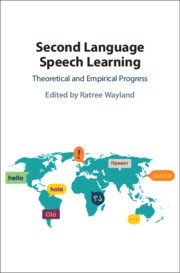Book contents
- Second Language Speech Learning
- Second Language Speech Learning
- Copyright page
- Dedication
- Contents
- Figures
- Tables
- Contributors
- Preface
- Acknowledgments
- Part I Theoretical Progress
- Chapter 1 The Revised Speech Learning Model (SLM-r)
- Chapter 2 The Revised Speech Learning Model (SLM-r) Applied
- Chapter 3 New Methods for Second Language (L2) Speech Research
- Chapter 4 Phonetic and Phonological Influences on the Discrimination of Non-native Phones
- Chapter 5 The Past, Present, and Future of Lexical Stress in Second Language Speech Production and Perception
- Part II Segmental Acquisition
- Part III Acquiring Suprasegmental Features
- Part IV Accentedness and Acoustic Features
- Part V Cognitive and Psychological Variables
- Index
- References
Chapter 3 - New Methods for Second Language (L2) Speech Research
from Part I - Theoretical Progress
Published online by Cambridge University Press: 21 January 2021
- Second Language Speech Learning
- Second Language Speech Learning
- Copyright page
- Dedication
- Contents
- Figures
- Tables
- Contributors
- Preface
- Acknowledgments
- Part I Theoretical Progress
- Chapter 1 The Revised Speech Learning Model (SLM-r)
- Chapter 2 The Revised Speech Learning Model (SLM-r) Applied
- Chapter 3 New Methods for Second Language (L2) Speech Research
- Chapter 4 Phonetic and Phonological Influences on the Discrimination of Non-native Phones
- Chapter 5 The Past, Present, and Future of Lexical Stress in Second Language Speech Production and Perception
- Part II Segmental Acquisition
- Part III Acquiring Suprasegmental Features
- Part IV Accentedness and Acoustic Features
- Part V Cognitive and Psychological Variables
- Index
- References
Summary
The lack of appropriate methodology creates an obstacle to progress in L2 speech research. Specific suggestions are provided here regarding how to obtain samples of L1 and L2 speech production that are representative of bilinguals’ typical productions of L1 and L2 speech sounds. Recommendations are made regarding methods that might be used to assess the perception of L2 speech sounds, to determine when a new phonetic category has been formed, and to obtain more accurate estimates of percentage L1 and L2 use. Finally, a new technique is unveiled for measuring the quantity and quality of L2 input to which learners have been exposed. The new technique provides a way to determine, for the first time, what kinds of L2 input distributions promote the formation of new phonetic categories for L2 sounds.
Information
- Type
- Chapter
- Information
- Second Language Speech LearningTheoretical and Empirical Progress, pp. 119 - 156Publisher: Cambridge University PressPrint publication year: 2021
References
Accessibility standard: Unknown
Why this information is here
This section outlines the accessibility features of this content - including support for screen readers, full keyboard navigation and high-contrast display options. This may not be relevant for you.Accessibility Information
- 8
- Cited by
